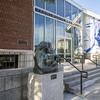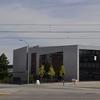April 23 - May 31 | Visionary Artist/Architect Don ZanFagna Collages at Studio Vendome
- NEW YORK, New York
- /
- April 23, 2014
“Don ZanFagna in the 1970s”
Studio Vendome, 330 Spring Street, New York NY
April 23-May 31, 2014 Opening Reception April 23, 6-8 pm
“Don ZanFagna in the 1970s: The Manhattan Project, The Cyborg Series, and The Pulse Domes,” an exhibition of work by artist, architect, inventor and provocateur Don ZanFagna, will be on view at Studio Vendome, 330 Spring Street gallery from April 23 - May 31, 2014. The opening reception will be held Wednesday April 23 from 6:00pm – 8:00pm.
Don ZanFagna [1929–2013] may be the most important, visionary artist/architect you've never heard of. During his lifetime he had more than 215 national and international, solo and group exhibitions.
ZanFagna’s utopian spirit and environmental consciousness were the driving forces behind the 49 extraordinary collages from three highly developed series of work that comprise this unique exhibition. The collages from The Manhattan Project (1969–1973); The Cyborg Series (1968–1974); and The Pulse Domes (1970–1979) are not only eerily prescient of current environmental realities but prefigure a number of artistic practices. The work reflects ZanFagna’s understanding of the rapid technological changes taking place in the 1960s and 1970s. Moreover, the collages’ compelling imagery portrays an idiosyncratic genius who defied being pigeonholed into any established category. Rather, these works present a dynamic amalgam of surrealism, futurism, constructivism, graphic design, and psychedelic Pop.
About The Manhattan Project, The Cyborg Series and The Pulse Domes
The Manhattan Project The collages in this series evoke warnings about the inevitable repercussions of how technology will deal with increasing population and environmental issues. Conceptually, ZanFagna presents human landscape figures, robots and cyborg parts as a new mythology tempered by a powerful environmental psyche.
The Cyborg Series The drawings and sculptures in this series are signals or warnings of things gone wrong. With a lot of irony and dark humor, ZanFagna mixed images of humans and machines, clones, architecture and landscape, biology and technology to examine future problems of DNA mixing.
The Pulse Dome This series is ZanFagna’s attempt to deal with the issue of sustainable shelter. While sustainability is an accepted orthodoxy today, in the 1960s, ZanFagna was not following a trend; he was helping to establish one.
About Don ZanFagna
Don ZanFagna is a Rhode Island native who held advanced degrees from the University of Michigan and the University of Southern California in painting, art, and architecture. In 1956-57 he earned a Fulbright to study in Italy. He exhibited in Rome with fellow Rhode Islander, Lee Bontecou [b.1931].
In 1959, he returned to the U.S and moved to Los Angeles where he had a number of solo exhibitions. At the same time he created a computerized communications distribution system called “Conceptual Communications Model IV 19” for the Rand Corporation.
He returned to New York in the 1960s and taught and eventually chaired the art department at Rutgers University. He was also visiting eco-architecture professor at Pratt Institute. In 1967-68 he founded his architectural practice, Infra/Ultra, which was based on a “very specific understanding of selected aspects of science, art, and nature; that invisible patterns are rapidly presenting us with a range and depth of information that makes it essential for our future and which is leading us to deeper and newer understanding of NATURE and ourselves. Indeed, yesterday’s ‘magic’ is today’s science.”
During the late 1960s, ZanFagna founded the Center for Ecological Action to Save the Environment (CEASE). In 1970 he joined Ralph Nader and Margaret Mead as a speaker at New York’s first Earth Day Teach-In at Union Square.
In 2011, the ZanFagna Foundation was created to exhibit his vast archive of notebooks, journals, drawings, photographs, paintings, collages, models, and ephemera. His writings overflow with remarkably prescient descriptions of such things as the development of the personal computer. He also predicted the widespread use of solar panel technologies and the use of biological processes such as algae and ethanol to generate energy. To be sure, every plan, model, and prototype was derived from a rigorous, disciplined scholarship.
ZanFagna traveled the world researching standing stones, Mayan ziggurats, and various ecological systems in search of underlying structures that might be adapted by humans to create habitats informed by these “invisible” or unknown processes. He scrutinized books, manuscripts, proceedings of conferences, and the popular press as he sought to uncover anything that might illuminate some aspect of his quarry on the art-human-ecology-technology continuum.
Most of the collages in this exhibition were on exhibit from 2010 through 2012, traveling to the Aspen Art Museum, the Tampa Museum of Art, and the Halsey Institute of Contemporary Art at the College of Charleston School of the Arts.
Contact:
Dan SchwartzSusan Grant Lewin Associates
212 947 4557
dan@susangrantlewin.com
Pier 90
New York, New York












100x100_c.jpg)

![Offering a Truce [Bested], 1895, is estimated to sell for between $1,300,000 and $1,800,000 on March 22, 2014, for The Russell: An Exhibition and Sale to Benefit the C.M. Russell Museum. Offering a Truce [Bested], 1895, is estimated to sell for between $1,300,000 and $1,800,000 on March 22, 2014, for The Russell: An Exhibition and Sale to Benefit the C.M. Russell Museum.](/images/c/a8/20/Dec10_Offering_a_Truce__Bested_300dpi100x100_c.jpg)